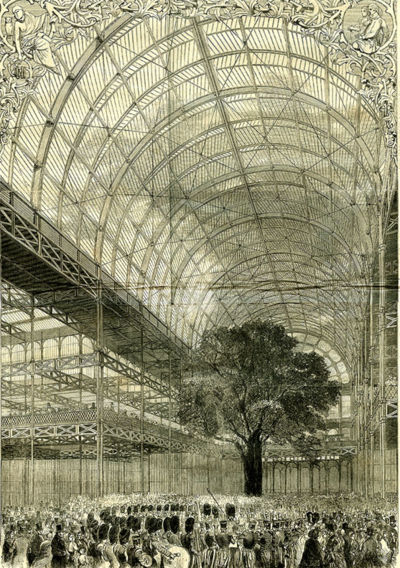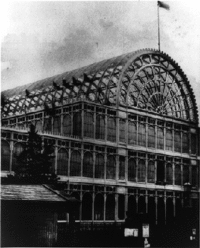Crystal Palace: Difference between revisions
imported>Russell Potter (→Planning and Construction: wikify) |
imported>Russell Potter |
||
| Line 6: | Line 6: | ||
==Planning and Construction== | ==Planning and Construction== | ||
[[Image:Cpplans.jpg|thumb|left|250px|Sir Joseph Paxton's original rough sketch of his plans for the Crystal Palace]] | [[Image:Cpplans.jpg|thumb|left|250px|Sir Joseph Paxton's original rough sketch of his plans for the Crystal Palace]] | ||
The Commissioners for the Great Exhibition originally envisioned a large, permanent building of brick and stone, and the first proposals submitted were massive indeed. However, with the choice of Hyde Park for the exhibition's site, many were concerned at the thought of such a large, fixed structure's impact on the park's open areas, which defenders hailed as one of the "lungs of the metropolis." It was at this point that Sir [[Joseph Paxton]] informally approached one of the commissioners, and sketched out a rough elevation (shown at left) of a multi-story glass structure, with cast iron uprights and supports, which he claimed could be speedily built, incorporating exiting trees ''inside'' its structure, and removed afterward, preserving the Park as a green space. With Paxton's proposal in hand, the Commissioners set forth a remarkable new set of criteria, including a much-reduced budget and a requirement that any structure built be dismantled at the conclusion of the Exhibition. Paxton's proposal, as they well knew, was now the only one which met the new criteria, and it was speedily approved. There was some criticism of the choice, as Paxton's previous projects had been greenhouses for the gardens of nobility, none of which was nearly as large as the proposed structure. [[Charles de Laet Waldo Sibthorp|Colonel Sibthorp]], a conservative [[Member of Parliament|MP]] with a history of bees in his bonnet, took up the charge against the plan, complaining that the trees would be suffocated, the grass killed off, and helpless exhibition-goers cut to ribbons by breaking glass. Sibthorp's criticisms failed to derail the commissioners, and the speed and skill with which the building arose spurred popular support. In the end, when | The Commissioners for the Great Exhibition originally envisioned a large, permanent building of brick and stone, and the first proposals submitted were massive indeed. However, with the choice of Hyde Park for the exhibition's site, many were concerned at the thought of such a large, fixed structure's impact on the park's open areas, which defenders hailed as one of the "lungs of the metropolis." It was at this point that Sir [[Joseph Paxton]] informally approached one of the commissioners, and sketched out a rough elevation (shown at left) of a multi-story glass structure, with cast iron uprights and supports, which he claimed could be speedily built, incorporating exiting trees ''inside'' its structure, and removed afterward, preserving the Park as a green space. With Paxton's proposal in hand, the Commissioners set forth a remarkable new set of criteria, including a much-reduced budget and a requirement that any structure built be dismantled at the conclusion of the Exhibition. Paxton's proposal, as they well knew, was now the only one which met the new criteria, and it was speedily approved. There was some criticism of the choice, as Paxton's previous projects had been greenhouses for the gardens of nobility, none of which was nearly as large as the proposed structure. [[Charles de Laet Waldo Sibthorp|Colonel Sibthorp]], a conservative [[Member of Parliament|MP]] with a history of bees in his bonnet, took up the charge against the plan, complaining that the trees would be suffocated, the grass killed off, and helpless exhibition-goers cut to ribbons by breaking glass. Sibthorp's criticisms failed to derail the commissioners, and the speed and skill with which the building arose spurred popular support. In the end, when [[Victoria of the United Kingdom|Queen Victoria]] and [[Prince Albert of Saxe-Coburg and Gotha|Prince Albert]] arrived for the grand opening of the building, the beauty, practicality, and strength of Paxton's designs were immediately evident, and the building was hailed as a new wonder of the world. [[William Makepeace Thackeray]], writing for [[Punch]], dubbed the building a "Crystal Palace," and it was known by that name for the rest of its existence. | ||
==The Great Exhibition== | ==The Great Exhibition== | ||
Revision as of 20:46, 3 June 2007
The Crystal Palace was built to house the Great Exhibition of the Industry of All Nations in Hyde Park, London, in 1851. After the Exhibition, it was moved and expanded and rebuilt on Sydenham Hill overlooking London, where it enjoyed a second life from 1854 until its destruction in a horrific fire in 1936.
The Crystal Palace is a significant structure in many ways; it was the first structure of its size assembled out of prefabricated parts; its system of horizontal trusses has since become one of the most widely-used construction methods in the world; it was at the time the world's largest enclosed open-air structure; and its success inspired the building of similar structures around the world, from the New York Crystal Palace in New York City to the Kibble Palace in Glasgow. It also has enormous historical and cultural significance as a symbol of technological prowess and imperial power, and in its second incarnation in Sydenham as a suburban pleasure palace drawing crowds away from the central metropolis. While at Sydenham, it also served as a concert hall, famous for its performances of Handel with a massed orchestra, choir, and the Palace's enormous organ; a recording of such a performance in 1888 is the earliest known recording of live music in exsitence. Its exterior parks, with fountains, terraces, and an outdoor exhibition of life-size dinosaur sculptures, was also highly influential. It also housed, from 1933 to 1936, the experimental studios of the Baird television company, which made regular short-wave broadcasts from its South Tower.
Planning and Construction
The Commissioners for the Great Exhibition originally envisioned a large, permanent building of brick and stone, and the first proposals submitted were massive indeed. However, with the choice of Hyde Park for the exhibition's site, many were concerned at the thought of such a large, fixed structure's impact on the park's open areas, which defenders hailed as one of the "lungs of the metropolis." It was at this point that Sir Joseph Paxton informally approached one of the commissioners, and sketched out a rough elevation (shown at left) of a multi-story glass structure, with cast iron uprights and supports, which he claimed could be speedily built, incorporating exiting trees inside its structure, and removed afterward, preserving the Park as a green space. With Paxton's proposal in hand, the Commissioners set forth a remarkable new set of criteria, including a much-reduced budget and a requirement that any structure built be dismantled at the conclusion of the Exhibition. Paxton's proposal, as they well knew, was now the only one which met the new criteria, and it was speedily approved. There was some criticism of the choice, as Paxton's previous projects had been greenhouses for the gardens of nobility, none of which was nearly as large as the proposed structure. Colonel Sibthorp, a conservative MP with a history of bees in his bonnet, took up the charge against the plan, complaining that the trees would be suffocated, the grass killed off, and helpless exhibition-goers cut to ribbons by breaking glass. Sibthorp's criticisms failed to derail the commissioners, and the speed and skill with which the building arose spurred popular support. In the end, when Queen Victoria and Prince Albert arrived for the grand opening of the building, the beauty, practicality, and strength of Paxton's designs were immediately evident, and the building was hailed as a new wonder of the world. William Makepeace Thackeray, writing for Punch, dubbed the building a "Crystal Palace," and it was known by that name for the rest of its existence.
The Great Exhibition
Together with Prince Albert, Queen Victoria opened the Palace on May 1, 1851. The opening ceremonies were massive and ornate, including a procession with the Royal Family, leading military officials, and the Duke of Wellington.


